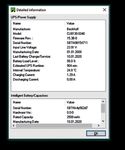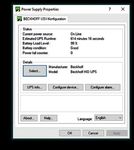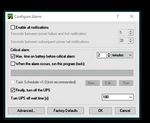Universal UPS systems with One Cable Technology minimize installation effort
←
→
Page content transcription
If your browser does not render page correctly, please read the page content below
| products PC Control 01 | 2021 CU81xx: new series of intelligent uninterruptible DC power supplies Universal UPS systems with One Cable Technology minimize installation effort The new CU81xx UPS series from Beckhoff can be used anywhere. Due above all to the flexible connection options extending up to One Cable Technology for uninterruptible power supplies (UPS-OCT), it is suitable for an extremely broad range of applications. In combination with the Beckhoff Industrial PCs, particularly efficient wiring is possible with just one cable for supply and communication through UPS-OCT. Signal modulation onto the 24 V supply line is a special feature of the UPS series, which is based on double-layer capacitors or NiMH batteries.
PC Control 01 | 2021 products
|
Fig. 1: The new universal UPS series covers a wide range Fig. 2: With just one CU81xx UPS, the 24 V DC supply voltage of both an IPC
of applications with three device versions currently. (in this case a C6030) and a Control Panel (in this case a CP29xx) can be secured.
The subject of UPS (uninterruptible power supply) is certainly as old as the The new CU81xx UPS series (fig. 1) belongs to the category of DC UPSs for 24 V
subject of electrical energy supply itself. If you regard rechargeable batteries as DC input and output voltage. However, the details of the exact implementation
the first approach to an offline UPS, then Count Alessandro Volta already built must be observed here too, because this UPS series has been developed with
an electrochemical battery storage system around 1770 in Italy. The purpose an eye to practical application in the industrial control cabinet. With regard to
of a “real” UPS, however, is to maintain the supply of power to a connected the operating behavior of the output voltage, it is most comparable with the
consumer intact without interruption in the event of a failure or malfunction of AC UPS type VI according to the IEC 62040-3 standard because, like the AC VI
the general power grid. type, the output voltage is electronically stabilized within the limit values for
normal operation. The CX81xx series is conceived for DC loads up to 240 W and
Selecting a UPS to suit the application currently features three devices:
The potential costs and risks caused by a malfunction or even a failure of – CU8110-0120: max. 120 W power, 0.9 Wh energy,
the supply voltage have grown continuously in the course of digitization, double-layer capacitors (EDLC)
industrialization and networking of our world, and are often out of all pro- – CU8130-0120: max. 120 W power, 15 Wh energy,
portion to the small cost of purchasing a UPS. Despite being a supposedly replaceable NiMH battery module
simple task, the selection of a UPS according to type and size is a multi-factor – CU8130-0240: max. 240 W power, 30 Wh energy,
decision that is made even more difficult by a confusing jumble of designa- replaceable NiMH battery module
tions. In principle, however, a distinction can be made between three types
of industry standard UPS: Due to the different energy and power classes, these UPSs are particularly
– UPSs with an AC input circuit and an AC output circuit (“traditional UPS”) suitable for the protection of control cabinet PCs, Embedded PCs, Panel PCs
– UPSs with an AC input circuit and a DC output circuit and other controllers (including third-party). They allow the wiring of a second
(“combined power supply/UPS”) consumer to the UPS, so a display, for example, can be powered without inter-
– UPSs with a DC input circuit and a DC output circuit (“DC UPS”) ruption in addition to the Industrial PC (fig. 2).| products PC Control 01 | 2021
Fig. 3: Basic block diagram of a UPS from the CU81xx series
The previous UPS solutions from Beckhoff (e.g. the IPC UPS with lead-acid – High discharge currents are possible.
batteries or the integrated capacitive 1-second UPSs) are retained. However, the – NiMH cells are free from cobalt and cadmium and, unlike Li-ion, are not
use of the new UPS technology in future product developments is preferred in classed as hazardous goods.
order to replace the lead-acid batteries with the more environmentally friendly – NiMH cells are sealed and do not degas in normal operation. Nevertheless,
NiMH battery technology. adequate ventilation should be ensured in case there should be a fault.
UPS series available with capacitors or batteries Beckhoff recommends the replacement of NiMH-based battery modules after
The types of energy storage in the new UPS series have been chosen consciously, five years. In this context, great importance was attached to the ease of replace-
because both storage technologies – EDLC or nickel-metal hydride batteries – ment and the best possible sustainability: after releasing just two fixing screws,
have their own advantages and disadvantages. One or the other technology will the plug-in battery module can simply be pulled out of the UPS and replaced by
be more or less suitable depending on the application. a new module. The UPS electronics can remain in the mounted and wired state
in the control cabinet and used further.
The key advantage of EDLC is that it is maintenance-free. Therefore, the energy
module doesn’t need to be replaced even after several decades. It is merely Functional principle of the UPS
necessary during the initial design to make sure that the required amount of The basic block diagram of the CU81xx UPS is shown in fig. 3. The input voltage
energy should be overdimensioned by a factor of 2 to 3. This is to make up for VIN typically comes from a single-phase (230 V) or three-phase (400 V) AC
the disadvantage of EDLCs, which is that the charging capacity reduces over power supply, which provides the 24 V DC operating voltage on the secondary
the course of years. It is proven practice to assume a maximum loss of capacity side, regulated or unregulated. The charging electronics takes the energy for
of 30% over a period of 10 years. This means, for example, a maximum loss charging the energy carrier, i.e. the batteries or capacitors, from this input volt-
of energy of 51% after 20 years or 66% after 30 years. In practical use, such age. The charging electronics ensures that all parameters of the energy carrier
double-layer capacitors have proven themselves to be maintenance-free energy (e.g. maximum charge/discharge currents, temperatures, minimum energy)
storage devices capable of supporting high currents in numerous application remain within the permitted limits.
examples – including and especially in UPS applications.
If the input voltage is at least 20.2 V (24 V – 15%), the UPS, which is connected
If you’re looking for a storage device with a higher energy density than EDLCs, between the AC power supply and the load to be supported, always supplies at
nickel-metal hydride offers many advantages as a battery technology: least 24 V at the output due to a step-up converter. If the input voltage drops
– Newer NiMH batteries have no loss of capacity down to –10 °C. below this value, operation is switched to UPS mode and the output is supplied
– The number of cycles is around two to four times higher than with lead batteries. by the energy storage device (UPS mode). The UPS then continues to supplyPC Control 01 | 2021 products
|
Fig. 4: The UPS software for the CU81xx series from Beckhoff displays all relevant Andreas Thome, Senior Product Manager
UPS parameters and enables the flexible configuration of UPS functions. PC Control, Beckhoff Automation
exactly 24 V. In the case of an input voltage from 24 V to 28.8 V (24 V + 20%), If UPS-OCT is not desired, or if the existing end device (older Beckhoff IPCs
this is present directly at the output due to the bypass circuit. If the input volt- or third-party hardware) does not have this function, the connection can be
age exceeds the threshold of 28.8 V, a transition to UPS mode takes place in realized via USB 2.0. The UPS can also be operated via digital 24 V I/O signals
order to protect the end devices. At the same time, an “overvoltage” warning is (e.g. with a PLC). For this purpose, the UPS provides information on the status
displayed. Therefore, less than 24 V and more than 28.8 V can never be present of the power supply and the charge level and can be switched on and off via
at the UPS output. inputs. In this way, smaller machines can be brought into a safe state prior to
shutting down, for example.
The CU81xx UPSs are wired via two 9-pin push-in plugs. The input voltage and
the devices to be supported are connected to the left-hand connector. There are Whether you choose OCT or USB, the corresponding UPS software from Beckhoff
two outputs (+24 V, 0 V) for this – one for the combined communication/power offers the same parameterization and monitoring options in every case (fig. 4).
supply and one for a further, non UPS-OCT-capable consumer (e.g. a display). It is currently available for Windows; other operating systems such as the new
The righthand 9-pin connector is equipped with digital control inputs and dig- TwinCAT/BSD are being prepared. The software installs a UPS service and its
ital status outputs. The complete control of the UPS is handled by the central function is independent of the TwinCAT automation software. PLC function
UPS controller, which orchestrates the interaction of all other microcontrollers blocks available in TwinCAT signal the UPS activation to the PLC programmer
(UPS-OCT communication, charge controller). and enable an appropriate response on the part of the control program.
Transparent communication via UPS-OCT or USB Published in Digital Automation 02/2020, Konradin publishing group, www.konradin.de
One of the particular advantages of the CU81xx DC UPS series is the various
possibilities to communicate with the devices and in this way to query the sta-
tus or to control the device state up to switch-off. The Beckhoff UPS-OCT One
Cable Technology, i.e. the communication modulated onto the two supply lines
(+24 V, 0 V) between IPC and UPS, is ideally suited for this. This is a half-duplex
connection, which means that both sides can transmit and receive, but not at
the same time. The use of the supply lines, which exist anyway, for the digital
transmission saves having to use an additional data line, but requires both
sides to be UPS-OCT-capable. This will initially only be possible with controllers
from Beckhoff. More information:
www.beckhoff.com/cu81xxYou can also read

























































